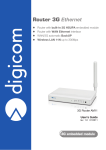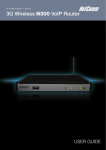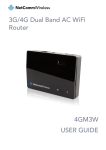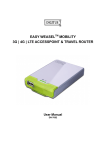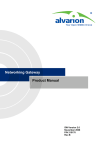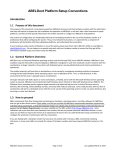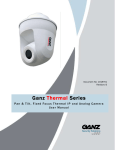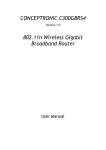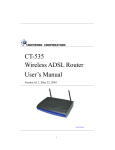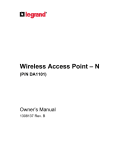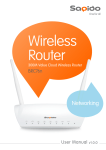Download DN-7061_manual_manual english_20110704
Transcript
WHITE WEASEL WIRELESS 150N 3G | 4G | LTE ACCESSPOINT & ROUTER USER’S MANUAL Copyright The contents of this publication may not be reproduced in any part or as a whole, stored, transcribed in an information retrieval system, translated into any language, or transmitted in any form or by any means, mechanical, magnetic, electronic, optical, photocopying, manual, or otherwise, without the prior written permission. Trademarks All products, company, brand names are trademarks or registered trademarks of their respective companies. They are used for identification purpose only. Specifications are subject to be changed without prior notice. FCC Interference Statement This equipment has been tested and found to comply with the limits for a Class B digital device pursuant to Part 15 of the FCC Rules. These limits are designed to provide reasonable protection against radio interference in a commercial environment. This equipment can generate, use and radiate radio frequency energy and, if not installed and used in accordance with the instructions in this manual, may cause harmful interference to radio communications. Operation of this equipment in a residential area is likely to cause interference, in which case the user, at his own expense, will be required to take whatever measures are necessary to correct the interference. CE Declaration of Conformity This equipment complies with the requirements relating to electromagnetic compatibility, EN 55022/A1 Class B. 1 TABLE OF CONTENTS COPYRIGHT ............................................................................................................................. 1 FCC INTERFERENCE STATEMENT ....................................................................................... 1 CHAPTER 1 INTRODUCTION ............................................................................................. 3 1.1 PACKAGE LIST .............................................................................................. 3 1.2 HARDWARE INSTALLATION ........................................................................ 4 CHAPTER 2 GETTING STARTED WITH EASY SETUP UTILITY...................................... 6 2.1 EASY SETUP BY WINDOWS UTILITY .......................................................... 6 2.2 EASY SETUP BY CONFIGURING WEB PAGES ........................................ 11 CHAPTER 3 MAKING CONFIGURATION ........................................................................ 15 3.1 BASIC SETTING ............................................................................................. 15 3.2 FORWARDING RULES .................................................................................. 32 3.2.1 VIRTUAL SERVER ............................................................................... 32 3.2.2 SPECIAL AP......................................................................................... 33 3.2.3 MISCELLANEOUS ............................................................................... 34 3.3 SECURITY SETTING ....................................................................................... 35 3.4 ADVANCED SETTING ..................................................................................... 41 3.5 TOOL BOX........................................................................................................ 48 CHAPTER 4 TROUBLESHOOTING .................................................................................. 51 APPENDIX A. SPEC SUMMARY TABLE .............................................................................. 55 APPENDIX B. LICENSING INFORMATION .......................................................................... 56 2 Chapter 1 Introduction The Wi-Fi Combo Router is a high-performance tool that supports wireless networking at home, work, or in a public place. The Wi-Fi Combo Router supports a USB 3G modem card, either WCDMA or EVDO and even HSDPA as well, and supports wireless data transfers up to 150M bps, and wired data transfers up to 100 Mbps. The WiFi Combo Router is compatible with industry security features. 1.1 Package List Items 1 Description Wi-Fi Combo Router Contents Quantity 1 2 Power adapter 1 3 CD 1 3 1.2 Hardware Installation A. Hardware configuration Antenna Reset Button Mobile/Status LED WAN LED WiFi LED LAN LED WPS Button Power JACK WAN PORT LAN PORT USB PORT 4 B. Installation Steps Note: DO NOT connect the router to power before performing the installation steps below. Step 1. Plug a USB modem into USB port. Step 2. Insert RJ45 cable into LAN Port on the back panel of the router. Then plug the other end of into computer. Step 3. Plug the power jack into the receptor on the back panel of the router. Then plug the other end into a wall outlet or power strip. 5 Chapter 2 Getting Started with Easy Setup Utility There are two approaches for you to set up the Wi-Fi Combo Router quickly and easily. One is through executing the provided Windows Easy Setup Utility on your PC, and the other is through browsing the device web pages and configuration. 2.1 Easy Setup by Windows Utility Step 1: Install the Easy Setup Utility from the provided CD then follow the steps to configure the device. Step 2: Select Language then click “Next” to continue. Step 3: Then click the “Wizard” to continue. 6 Step 4: Click “Next” to continue. Step 5: Select Wireless Enable, and then click “Next” to continue. Step 6: Enter SSID, Channel and Security options, and then click “Next” to continue. 7 Step 7: Click” Let me select WAN service by myself” to select WAN service manually. Step 8: Select 3G Service by clicking 3G icon to continue. Step 9-1: Select “Auto-Detection” and the Utility will try to detect and configure the required 3G service settings automatically. Click “Next” to continue. 8 Step 9-2: Or you can select “Manual” and manually fill in the required 3G service settings provided by your ISP. Click “Next” to continue. Step 10: Click “Next” to save your setting. Step 11: The Wi-Fi Combo Router is rebooted to make your entire configuration take effect. 9 Step 12: Click “Next” to test the Internet connection or you can ignore test. Step 13: Click “Next” to test WAN Networking service. Step 14: Setup is completed. 10 2.2 Easy Setup by Configuring Web Pages You can also browse web UI to configure the device. Browse to Activate the Setup Wizard Type in the IP Address (http://192.168.123.254) Type in the default password “admin” in the System Password and then click ‘login’ button. Select your language. Select “Wizard” for basic settings with simple way. Press “Next” to start the Setup Wizard. 11 Configure with the Setup Wizard Step 1: Change System Password. Set up your system password. (Default:admin) Step 2: Select Time Zone. Step 3: Select WAN Type. Choose Auto-Detecting or Manually to set WAN Type. 12 Step 4: Select Wan Type. If you want to use 3G service as the main internet access, please set the WAN interface as “Wireless WAN” and the WAN type as “3G”. Step 5: 3G Mode. Select Auto-Detection then click “Next” to continue. Step 6: Set up your Wireless Network. Set up your SSID. 13 Step 7: Setup your Encryption Key here, then click”Next” to continue. Step 8: Apply your Setting. Then click Apply Setting. Step 9: Click Finish to complete it. 14 Chapter 3 Making Configuration Whenever you want to configure your network or this device, you can access the Configuration Menu by opening the web-browser and typing in the IP Address of the device. The default IP Address is: 192.168.123.254 Enter the default password “admin” in the System Password and then click ‘login’ button. Then, you can browse the “Advanced” configuration pages for configuring this device. 3.1 Basic Setting 15 3.1.1. Network Setup 1. LAN IP Address: The local IP address of this device. The computers on your network must use the LAN IP address of this device as their Default Gateway. You can change it if necessary. 2. Subnet Mask: Input your Subnet mask. (All devices in the network must have the same subnet mask.) The default subnet mask is 255.255.255.0. 3. WAN Interface: Select Ethernet WAN or Wireless WAN to continue. 4. WAN Type: WAN connection type of your ISP. You can click WAN Type combo button to choose a correct one from the following options: 16 A. 3G 17 For 3G WAN Networking. The WAN fields may not be necessary for your connection. The information on this page will only be used when your service provider requires you to enter a User Name and Password to connect with the 3G network. Please refer to your documentation or service provider for additional information. 1. Dial-Up Profile: Select “Auto-Detection” or “Manual” to continue. If “Auto-Detection” is selected, the device will try to configure some ISP specific dial-up parameters automatically according to the Country, Telecom, and 3G Network information you entered.. 2. Country: Select your country. 3. Telecom: Select your telecom. 4. 3G Network: Select the 3G Network 5. APN: Enter the APN for your PC card here.(Optional) 6. Pin Code: Enter the Pin Code for your SIM card. (Optional) 7. Dial-Number: This field should not be altered except when required by your service provider. 8. Account: Enter the new User Name for your PC card here, you can contact to your ISP to get it. (Optional) 9. Password: Enter the new Password for your PC card here, you can contact to your ISP to get it. (Optional) 10. Authentication: Choose your authentication. 11. Primary DNS: This feature allows you to assign a Primary DNS Server, contact to your ISP to get it. (Optional) 12. Secondary DNS: This feature allows you to assign a Secondary DNS Server, you can contact to your ISP to get it. (Optional) 13. Connection Control: Select your connection control. There are 3 modes to select: Connect-on-demand: The device will link up with ISP when the clients send outgoing packets. Auto Reconnect (Always-on): The device will link with ISP until the connection is established. Manually: The device will not make the link until someone clicks the connect-button in the Status-page. 14. Keep Alive: This feature must collocate with the function "Auto" of "Auto Connect". Enable it to keep the connection always be established. 15. LCP Echo Request: Enter the time interval and the maximum failure count. The device will constantly send out the LCP packets for keeping the connection alive. 16. Ping Remote Host: Enter the Remote host IP and the time interval to send the ping packets for keeping the connection alive. 18 B. Static IP Address: 1. Activate WWAN for Auto-Failover: With this function enabled, when the Ethernet WAN connection is broken, the device will automatically activate the WWAN connection and keep you connected to internet with the alternative WWAN broadband service. Meanwhile, if the device detected that the Ethernet WAN connection is recovered, your broadband connection will be switched to use the Ethernet WAN service. 2. WAN IP Address, Subnet Mask, Gateway, Primary and Secondary DNS: Enter the proper settings provided by your ISP. 19 C. Dynamic IP Address: 1. Activate WWAN for Auto-Failover: With this function enabled, when the Ethernet WAN connection is broken, the device will automatically activate the WWAN connection and keep you connected to internet with the alternative WWAN broadband service. Meanwhile, if the device detected that the Ethernet WAN connection is recovered, your broadband connection will be switched to use the Ethernet WAN service 2. Host Name: Optional, required by some ISPs, for example, @Home. 3. Connection Control: There are 3 modes to select: Connect-on-demand: The device will link up with ISP when the clients send outgoing packets. Auto Reconnect (Always-on): The device will link with ISP until the connection is established. Manually: The device will not make the link until someone clicks the connect-button in the Status-page. 20 D. PPP over Ethernet 1. Activate WWAN for Auto-Failover: With this function enabled, when the Ethernet WAN connection is broken, the device will automatically activate the WWAN connection and keep you connected to internet with the alternative WWAN broadband service. Meanwhile, if the device detected that the Ethernet WAN connection is recovered, your broadband connection will be switched to use the Ethernet WAN service 2. PPPoE Account and Password: The account and password your ISP assigned to you. For security, this field appears blank. If you don't want to change the password, leave it blank. 21 3. Connection Control: There are 3 modes to select: Connect-on-demand: The device will link up with ISP when the clients send outgoing packets. Auto Reconnect (Always-on): The device will link with ISP until the connection is established. Manually: The device will not make the link until someone clicks the connect-button in the Status-page. 4. Maximum Idle Time: the amount of time of inactivity before disconnecting your PPPoE session. Set it to zero or enable “Auto-reconnect” to disable this feature. 5. PPPoE Service Name: Optional. Input the service name if your ISP requires it. Otherwise, leave it blank. 6. Maximum Transmission Unit (MTU): Most ISP offers MTU value to users. The default MTU value is 0 (auto). 22 E. PPTP 1. Activate WWAN for Auto-Failover: With this function enabled, when the Ethernet WAN connection is broken, the device will automatically activate the WWAN connection and keep you connected to internet with the alternative WWAN broadband service. Meanwhile, if the device detected that the Ethernet WAN connection is recovered, your broadband connection will be switched to use the Ethernet WAN service 2. IP Mode: Please check the IP mode your ISP assigned, and select “Static IP Address” or “Dynamic IP Address”. 3. My IP Address and My Subnet Mask: The private IP address and subnet mask your ISP assigned to you. 23 4. Gateway IP and Server IP Address/Name: The IP address of the PPTP server and designated Gateway provided by your ISP. 5. PPTP Account and Password: The account and password your ISP assigned to you. If you don't want to change the password, keep it blank. 6. Connection ID: Optional. Input the connection ID if your ISP requires it. 7. Maximum Idle Time: the time of no activity to disconnect your PPTP session. Set it to zero or enable “Auto-reconnect” to disable this feature. If Auto-reconnect is enabled, this device will connect with ISP automatically after system is restarted or connection is dropped. 8. Connection Control: There are 3 modes to select: Connect-on-demand: The device will link up with ISP when the clients send outgoing packets. Auto Reconnect (Always-on): The device will link with ISP until the connection is established. Manually: The device will not make the link until someone clicks the connect-button in the Status-page. 9. Maximum Transmission Unit (MTU): Most ISP offers MTU value to users. The default MTU value is 0 (auto). 24 F. L2TP 1. Activate WWAN for Auto-Failover: With this function enabled, when the Ethernet WAN connection is broken, the device will automatically activate the WWAN connection and keep you connected to internet with the alternative WWAN broadband service. Meanwhile, if the device detected that the Ethernet WAN connection is recovered, your broadband connection will be switched to use the Ethernet WAN service 2. IP Mode: Please check the IP mode your ISP assigned, and select “Static IP Address” or “Dynamic IP Address”. 3. My IP Address and My Subnet Mask: The private IP address and subnet mask your ISP assigned to you. 4. Gateway IP and Server IP Address/Name: The IP address of the L2TP server and designated Gateway provided by your ISP. 25 5. L2TP Account and Password: The account and password your ISP assigned to you. If you don't want to change the password, keep it blank. 6. Connection ID: Optional. Input the connection ID if your ISP requires it. 7. Maximum Idle Time: The time of no activity to disconnect your L2TP session. Set it to zero or enable “Auto-reconnect” to disable this feature. If Auto-reconnect is enabled, this device will connect with ISP automatically, after system is restarted or connection is dropped. 8. Connection Control: There are 3 modes to select: Connect-on-demand: The device will link up with ISP when the clients send outgoing packets. Auto Reconnect (Always-on): The device will link with ISP until the connection is established. Manually: The device will not make the link until someone clicks the connect-button in the Status-page. 9. Maximum Transmission Unit (MTU): Most ISP offers MTU value to users. The default MTU value is 0 (auto). 3.1.2. DHCP Server 1. DHCP Server: Choose either Disable or Enable. If you enable the DHCP Server function, the following settings will be effective. 2. IP Pool Starting/Ending Address: Whenever there is a request, the DHCP server will automatically allocate an unused IP address from the IP address pool to the requesting computer. You must specify the starting / ending address of the IP address pool. 3. Lease Time: DHCP lease time to the DHCP client. 4. Domain Name: Optional, this information will be passed to the clients. Press “More>>” and you can find more settings 5. Primary DNS/Secondary DNS: Optional. This feature allows you to assign a DNS Servers 26 6. Primary WINS/Secondary WINS: Optional. This feature allows you to assign a WINS Servers 7. Gateway: Optional. Gateway Address would be the IP address of an alternate Gateway. This function enables you to assign another gateway to your PC, when DHCP server offers an IP to your PC. Click on “Save” to store your settings or click “Undo” to give up the changes. Press “Clients List” and the list of DHCP clients will be shown consequently. Press “Fixed Mapping” and the DHCP Server will reserve the special IP for designated MAC address. 27 3.1.3. Wireless Settings Wireless settings allow you to set the wireless configuration items. 1. Wireless Module: You can enable or disable wireless function. 2. Network ID (SSID): Network ID is used for identifying the Wireless LAN (WLAN). Client stations can roam freely over this device and other Access Points that have the same Network ID. (The factory default setting is “default”) 3. SSID Broadcast: The router will broadcast beacons that have some information, including SSID so that wireless clients can know how many AP devices by scanning the network. Therefore, if this setting is configured as “Disable”, the wireless clients can not find the device from beacons. 4. Channel: The radio channel number. The permissible channels depend on the Regulatory Domain. The factory default setting is as follow: channel 1~11 for North America. (Channel 1~13 for European (ETSI); channel1~ 14 for Japan). 5. Wireless Mode: Choose “B/G mixed”, “B only”, “G only”, “N only”, “G/N mixed” or “B/G/N mixed”. The factory default setting is “B/G/N mixed”. 6. Authentication mode: You may select one of authentication to secure your wireless network: Open Shared, Auto, WPA-PSK, WPA, WPA2-PSK, WPA2, WPA-PSK/WPA2-PSK, or WPA /WPA2. 28 Open Open system authentication simply consists of two communications. The first is an authentication request by the client that contains the station ID (typically the MAC address). This is followed by an authentication response from the AP/router containing a success or failure message. An example of when a failure may occur is if the client's MAC address is explicitly excluded in the AP/router configuration. Shared Shared key authentication relies on the fact that both stations taking part in the authentication process have the same "shared" key or passphrase. The shared key is manually set on both the client station and the AP/router. Three types of shared key authentication are available today for home or small office WLAN environments. Auto The AP will Select the Open or Shared by the client’s request automatically. WPA-PSK Select Encryption and Pre-share Key Mode If you select HEX, you have to fill in 64 hexadecimal (0, 1, 2…8, 9, A, B…F) digits. If you select ASCII, the length of pre-share key is from 8 to 63. Fill in the key, Ex 12345678 WPA Check Box was used to switch the function of the WPA. When the WPA function is enabled, the Wireless user must authenticate to this router first to use the Network service. RADIUS Server IP address or the 802.1X server’s domain-name. Select Encryption and RADIUS Shared Key If you select HEX, you have to fill in 64 hexadecimal (0, 1, 2…8, 9, A, B…F) digits If you select ASCII, the length of pre-share key is from 8 to 63. Key value shared by the RADIUS server and this router. This key value is consistent with the key value in the RADIUS server. WPA-PSK2 WPA-PSK2 user AES and TKIP for Same the encryption, the others are same the WPA-PSK. 29 WPA2 WPA2 add uses AES and TKIP for encryption, the others are same the WPA. WPA-PSK/WPA-PSK2 Another encryption options for WPA-PSK-TKIP and WPA-PSK2-AES, the others are same the WPA-PSK. WPA/WPA2 Another encryption options for WPA-TKIP and WPA2-AES, the others are same the WPA. By pressing “WPS Setup”, you can configure and enable the easy setup feature WPS (Wi-Fi Protection Setup) for your wireless network. 1. WPS: You can enable this function by selecting “Enable”. WPS offers a safe and easy way to allow the wireless clients connected to your wireless network. 2. AP PIN: You can press Generate New Pin to get an AP PIN. 3. Config Mode: Select your config Mode from “Registrar” or “Enrollee”. 4. Config Status: It shows the status of your configuration. 5. Config Method: You can select the Config Method here from “Pin Code” or “Push Button”. 6. WPS status: According to your setting, the status will show “Start Process” or “No used” 30 Press “Wireless Clients List” and the list of wireless clients will be shown consequently. 3.1.4. Change Password You can change the System Password here. We strongly recommend you to change the system password for security reason. Click on “Save” to store your settings or click “Undo” to give up the changes. 31 3.2 Forwarding Rules 3.2.1 Virtual Server This product’s NAT firewall filters out unrecognized packets to protect your Intranet, so all hosts behind this product are invisible to the outside world. If you wish, you can make some of them accessible by enabling the Virtual Server Mapping. A virtual server is defined as a Service Port, and all requests to this port will be redirected to the computer specified by the Server IP. Virtual Server can work with Scheduling Rules, and give user more flexibility on Access control. For the details, please refer to Scheduling Rule. For example, if you have an FTP server (port 21) at 192.168.123.1, a Web server (port 80) at 192.168.123.2, and a VPN server at 192.168.123.6, then you need to specify the following virtual server mapping table: 32 Service Port Server IP Enable 21 192.168.123.1 V 80 192.168.123.2 V 1723 192.168.123.6 V Click on “Save” to store your settings or click “Undo” to give up the changes. 3.2.2 Special AP Some applications require multiple connections, like Internet games, Video conferencing, Internet telephony, etc. Because of the firewall function, these applications cannot work with a pure NAT router. The Special Applications feature allows some of these applications to work with this product. If the mechanism of Special Applications fails to make an application work, try setting your computer as the DMZ host instead. 1. Trigger: The outbound port number issued by the application. 2. Incoming Ports: When the trigger packet is detected, the inbound packets sent to the specified port numbers are allowed to pass through the firewall. This device provides some predefined settings. Select your application and click “Copy to” to add the predefined setting to your list. Click on “Save” to store your settings or click “Undo” to give up the changes. 33 3.2.3 Miscellaneous 1. IP Address of DMZ Host DMZ (Demilitarized Zone) Host is a host without the protection of firewall. It allows a computer to be exposed to unrestricted 2-way communication for Internet games, Video conferencing, Internet telephony and other special applications. 2. UPnP Setting The device supports the UPnP function. If the OS of your client computer supports this function, and you enabled it, like Windows XP, you can see the following icon when the client computer gets IP from the device. Click on “Save” to store your settings or click “Undo” to give up the changes. 34 3.3 Security Setting 3.3.1 Packet Filters Packet Filter includes both outbound filter and inbound filter. And they have same way to setting. Packet Filter enables you to control what packets are allowed to pass the router. Outbound filter applies on all outbound packets. However, inbound filter applies on packets that destined to Virtual Servers or DMZ host only. You can select one of the two filtering policies: 1. Allow all to pass except those match the specified rules 2. Deny all to pass except those match the specified rules 35 You can specify 8 rules for each direction: inbound or outbound. For each rule, you can define the following: • Source IP address • Source port • Destination IP address • Destination port • Protocol: TCP or UDP or both. • Use Rule# For source or destination IP address, you can define a single IP address (4.3.2.1) or a range of IP addresses (4.3.2.1-4.3.2.254). An empty implies all IP addresses. For source or destination port, you can define a single port (80) or a range of ports (1000-1999). Add prefix "T" or "U" to specify TCP or UDP protocol. For example, T80, U53, U2000-2999, No prefix indicates both TCP and UDP are defined. An empty implies all port addresses. Packet Filter can work with Scheduling Rules, and give user more flexibility on Access control. For Detail, please refer to Scheduling Rule. Each rule can be enabled or disabled individually. Click on “Save” to store your settings or click “Undo” to give up the changes. 36 3.3.2 Domain Filters Domain Filter prevents users under this device from accessing specific URLs. 1. Domain Filter: Check if you want to enable Domain Filter. 2. Log DNS Query: Check if you want to log the action when someone accesses the specific URLs. 3. Privilege IP Address Range: Setting a group of hosts and privilege these hosts to access network without restriction. 4. Domain Suffix: A suffix of URL can be restricted, for example, ".com", "xxx.com". 5. Action: When someone is accessing the URL met the domain-suffix, what kind of action you want. Check “Drop” to block the access. Check “Log” to log this access. 6. Enable: Check to enable each rule. Click on “Save” to store your settings or click “Undo” to give up the changes. 37 3.3.3 URL Blocking URL Blocking will block LAN computers to connect with pre-define Websites. The major difference between “Domain filter” and “URL Blocking” is Domain filter require user to input suffix (like .com or .org, etc), while URL Blocking require user to input a keyword only. In other words, Domain filter can block specific website, while URL Blocking can block hundreds of websites by simply a keyword. 1. URL Blocking: Check if you want to enable URL Blocking. 2. URL: If any part of the Website's URL matches the pre-defined word, the connection will be blocked. For example, you can use pre-defined word "sex" to block all websites if their URLs contain pre-defined word "sex". 3. Enable: Check to enable each rule. Click on “Save” to store your settings or click “Undo” to give up the changes. 38 3.3.4 MAC Control MAC Address Control allows you to assign different access right for different users and to assign a specific IP address to a certain MAC address. 1. MAC Address Control: Check “Enable” to enable the “MAC Address Control”. All of the settings in this page will take effect only when “Enable” is checked. 2. Connection control: Check "Connection control" to enable the controlling of which wired and wireless clients can connect with this device. If a client is denied to connect with this device, it means the client can't access to the Internet either. Choose "allow" or "deny" to allow or deny the clients, whose MAC addresses are not in the "Control table" (please see below), to connect with this device. 3. Association control: Check "Association control" to enable the controlling of which wireless client can associate to the wireless LAN. If a client is denied to associate to the wireless LAN, it means the client can't send or receive any data via this device. Choose "allow" or "deny" to allow or deny the clients, whose MAC addresses are not in the "Control table", to associate to the wireless LAN. Click on “Save” to store your settings or click “Undo” to give up the changes. 39 3.3.5 Miscellaneous 1. Administrator Time-out: The time of no activity to logout automatically, you may set it to zero to disable this feature. 2. Remote Administrator Host/Port In general, only Intranet user can browse the built-in web pages to perform administration task. This feature enables you to perform administration task from remote host. If this feature is enabled, only the specified IP address can perform remote administration. If the specified IP address is 0.0.0.0, any host can connect with this product to perform administration task. You can use subnet mask bits "/nn" notation to specified a group of trusted IP addresses for example, "10.1.2.0/24". NOTE: When Remote Administration is enabled, the web server port will be shifted to 80. You can change web server port to other port, too. 3. Discard PING from WAN side: When this feature is enabled, any host on the WAN cannot ping this product. 4. DoS Attack Detection: When this feature is enabled, the router will detect and log the DoS attack comes from the Internet. Currently, the router can detect the following DoS attack: SYN Attack, WinNuke, Port Scan, Ping of Death, Land Attack etc. Click on “Save” to store your settings or click “Undo” to give up the changes. 40 3.4 Advanced Setting 3.4.1 System Log This page support two methods to export system logs to specific destination by means of syslog (UDP) and SMTP(TCP). The items you have to setup including: 41 1. IP Address for Sys log: Host IP of destination where sys log will be sent to. Check Enable to enable this function. 2. E-mail Alert Enable: Check if you want to enable Email alert (send syslog via email). 3. SMTP Server IP and Port: Input the SMTP server IP and port, which are connected with ':'. If you do not specify port number, the default value is 25. For example, "mail.your_url.com" or "192.168.1.100:26". 4. Send E-mail alert to: The recipients who will receive these logs, you can assign more than 1 recipient, using ';' or ',' to separate these email addresses. 5. E-mail Subject: The subject of email alert, this setting is optional. Click on “Save” to store your settings or click “Undo” to give up the changes. 3.4.2 Dynamic DNS To host your server on a changing IP address, you have to use dynamic domain name service (DDNS). So that anyone wishing to reach your host only needs to know the name of it. Dynamic DNS will map the name of your host to your current IP address, which changes each time you connect your Internet service provider. Before you enable Dynamic DNS, you need to register an account on one of these Dynamic DNS servers that we list in Provider field. To enable Dynamic DNS click the check box next to Enable in the DDNS field. Next you have to enter the appropriate information about your Dynamic DNS Serve .Provider, Host Name, Username/E-mail, and Password/Key. You can get this information when you register an account on a Dynamic DNS server. Click on “Save” to store your settings or click “Undo” to give up the changes. 42 3.4.3 QOS Provide different priority to different users or data flows, or guarantee a certain level of performance. 1. QOS Control: Check Enable to enable this function. 2. Bandwidth of Upstream: Set the limitation of upstream bandwidth 3. Local IP : Ports: Define the Local IP address and ports of packets 4. Remote IP : Ports: Define the Remote IP address and ports of packets 5. QoS Priority: This defines the priority level of the current Policy Configuration. Packets associated with this policy will be serviced based upon the priority level set. For critical applications High or Normal level is recommended. For non-critical applications select a Low level. 6. Enable: Check to enable the corresponding QOS rule. 7. User Rule#: The QoS rule can work with Scheduling Rule number#. Please refer to the Section 3.1.4.7 Schedule Rule. Click on “Save” to store your settings or click “Undo” to give up the changes. 43 3.4.4 SNMP In brief, SNMP, the Simple Network Management Protocol, is a protocol designed to give a user the capability to remotely manage a computer network by polling and setting terminal values and monitoring network events. 1. Enable SNMP: You must check “Local”, “Remote” or both to enable SNMP function. If “Local” is checked, this device will response request from LAN. If “Remote” is checked, this device will response request from WAN. 2. Get Community: The community of GetRequest that this device will respond. 3. Set Community: The community of SetRequest that this device will accept. 4. IP 1, IP 2, IP 3, IP 4: Enter the IP addresses of your SNMP Management PCs. User has to configure to where this device should send SNMP Trap message. 5. SNMP Version: Select proper SNMP Version that your SNMP Management software supports. 6. WAN Access IP Address: If you want to limit the remote SNMP access to specific computer, please enter the PC’s IP address. The default value is 0.0.0.0, and it means that any internet connected computer can get some information of the device with SNMP protocol. Click on “Save” to store your settings or click “Undo” to give up the changes. 44 3.4.5 Routing If you have more than one routers and subnets, you will need to enable routing table to allow packets to find proper routing path and allow different subnets to communicate with each other. The routing table allows you to determine which physical interface address to use for outgoing IP data grams. 1. Dynamic Routing: Routing Information Protocol (RIP) will exchange information about destinations for computing routes throughout the network. Please select RIPv2 only if you have different subnet in your network. Otherwise, please select RIPv1 if you need this protocol. 2. Static Routing: For static routing, you can specify up to 8 routing rules. You can enter the destination IP address, subnet mask, gateway, and hop for each routing rule, and then enable or disable the rule by checking or un-checking the Enable checkbox. Click on “Save” to store your settings or click “Undo” to give up the changes. 45 3.4.6 System Time 1. Time Zone: Select a time zone where this device locates. 2. Auto-Synchronization: Check the “Enable” checkbox to enable this function. Besides, you can select a NTP time server to consult UTC time. 3. Sync with Time Server: Click on the button if you want to set Date and Time by NTP Protocol manually. 4. Sync with my PC: Click on the button if you want to set Date and Time using PC’s Date and Time manually. . Click on “Save” to store your settings or click “Undo” to give up the changes. 46 3.4.7 Scheduling You can set the schedule time to decide which service will be turned on or off. 1. Schedule: Check to enable the schedule rule settings. 2. Add New Rule: To create a schedule rule, click the “Add New Rule” button. You can edit the Name of Rule, Policy, and set the schedule time (Week day, Start Time, and End Time). The following example configures “ftp time” as everyday 14:10 to 16:20. Click on “Save” to store your settings or click “Undo” to give up the changes. 47 3.5 Tool Box 3.5.1 System Info You can view the System Information and System log, and download/clear the System log, in this page. 48 3.5.2 Firmware Upgrade You can upgrade firmware by clicking “Upgrade” button. 3.5.3 Backup Setting You can backup your settings by clicking the “Backup Setting” function item and save it as a bin file. Once you want to restore these settings, please click Firmware Upgrade button and use the bin file you saved. 3.5.4 Reset to Default You can also reset this device to factory default settings by clicking the Reset to default function item. 49 3.5.5 Reboot You can also reboot this device by clicking the Reboot function item. 3.5.6 Miscellaneous 1. Domain Name or IP address for Ping Test: Allow you to configure an IP, and ping the device. You can ping a specific IP to test whether it is alive. Click on “Save” to store your settings or click “Undo” to give up the changes. 50 Chapter 4 . Troubleshooting This Chapter provides solutions to problems for the installation and operation of the WiFi Combo Router. You can refer to the following if you are having problems. 1 Why can’t I configure the router even the cable is plugged and the LED is lit? Do a Ping test to make sure that the WiFi Combo Router is responding. Note: It is recommended that you use an Ethernet connection to configure it. Go to Start > Run. 1. Type cmd. 2. Press OK. 3. Type ipconfig to get the IP of default gateway. 4. Type “ping 192.168.123.254”. Assure that you ping the correct IP Address assigned to the WiFi Combo Router. It will show four replies if you ping correctly. Ensure that your Ethernet Adapter is working, and that all network drivers are installed properly. Network adapter names will vary depending on your specific adapter. The installation steps listed below are applicable for all network adapters. 1. Go to Start > Right click on “My Computer” > Properties. 2. Select the Hardware Tab. 3. Click Device Manager. 4. Double-click on “Network Adapters”. 51 5. Right-click on Wireless Card bus Adapter or your specific network adapter. 6. Select Properties to ensure that all drivers are installed properly. 7. Look under Device Status to see if the device is working properly. 8. Click “OK”. 9. 2 What can I do if my Ethernet connection does not work properly? A. Make sure the RJ45 cable connect with the router. B. Ensure that the setting on your Network Interface Card adapter is “Enabled”. C. If settings are correct, ensure that you are not using a crossover Ethernet cable, not all Network Interface Cards are MDI/MDIX compatible, and use a patch cable is recommended. D. If the connection still doesn’t work properly, then you can reset it to default. 3 Problems with 3G connection? A. What can I do if the 3G connection is failed by Auto detection? Maybe the device can’t recognize your ISP automatically. Please select “Manual” mode, and filling in dial-up settings manually. B. What can I do if my country and ISP are not in the list? Please choose “Others” item from the list, and filling in dial-up settings manually. C. What can I do if my 3G connection is failed even the dongle is plugged? Please check the following items: I. Make sure you have inserted a validated SIM card in the 3G data card, and the subscription from ISP is still available II. If you activate PIN code check feature in SIM card, making sure the PIN code you fill in dial-up page is correct D. III. Checking with your ISP to see all dial-up settings are correct IV. Make sure 3G signal from your ISP is available in your environment What can I do if my router can’t recognize my 3G data card even it is plugged? There might be compatibility issue with some certain 3G cards. Please check the latest compatibility list to see if your 3G card is already supported. E. What should I insert in APN, PIN Code, Account, Password, Primary DNS, and Secondary DNS? The device will show this information after you choose country and Telcom. You can also check these values with your ISP. 52 F. Which 3G network should I select? It depends on what service your ISP provide. Please check your ISP to know this information. G. Why my 3G connection is keep dropping? Please check 3G signal strength from your ISP in your environment is above middle level. 4 Something wrong with the wireless connection? A. Can’t setup a wireless connection? I. Ensure that the SSID and the encryption settings are exactly the same to the Clients. II. Move the WiFi Combo Router and the wireless client into the same room, and then test the wireless connection. III. Disable all security settings such as WEP, and MAC Address Control. IV. Turn off the WiFi Combo Router and the client, then restart it and then turn on the client again. V. Ensure that the LEDs are indicating normally. If no, make sure that the AC power and Ethernet cables are firmly connected. VI. Ensure that the IP Address, subnet mask, gateway and DNS settings are correctly entered for the network. VII. If you are using other wireless device, home security systems or ceiling fans, lights in your home, your wireless connection may degrade dramatically. Keep your product away from electrical devices that generate RF noise such as microwaves, monitors, electric motors… B. What can I do if my wireless client can not access the Internet? I. Out of range: Put the router closer to your client. II. Wrong SSID or Encryption Key: Check the SSID or Encryption setting. III. Connect with wrong AP: Ensure that the client is connected with the correct Access Point. i. Right-click on the Local Area Connection icon in the taskbar. ii. Select View Available Wireless Networks in Wireless Configure. Ensure you have selected the correct available network. iii. Reset the WiFi Combo Router to default setting 53 C. Why does my wireless connection keep dropping? I. Antenna Orientation. i. Try different antenna orientations for the WiFi Combo Router. ii. Try to keep the antenna at least 6 inches away from the wall or other objects. II. Try changing the channel on the WiFi Combo Router, and your Access Point and Wireless adapter to a different channel to avoid interference. III. Keep your product away from electrical devices that generate RF noise, like microwaves, monitors, electric motors, etc. 5 What to do if I forgot my encryption key? 1. Go back to advanced setting to set up your Encryption key again. 2. Reset the WiFi Combo Router to default setting 6 How to reset to default? 1. Ensure the WiFi Combo Router is powered on 2. Find the Reset button on the right side 3. Press the Reset button for 8 seconds and then release. 4. After the WiFi Combo Router reboots, it has back to the factory default settings. 54 Appendix A. Spec Summary Table LTE/3G Access Standards Wireless Standard Data Rate Frequency Range Coverage # of Channels Security Antenna Firewall Supported WAN type Connection Scheme NAT function VPN Config.& Management IP assignment Working Environment Power USB port IEEE 802.11b/g/n IEEE 802.3 IEEE 802.3u IEEE 802.11 B\G\N 11B: 11, 5.5, 2, 1 Mbps 11G: 54, 48, 36, 24, 18, 12, 9, and 6 Mbps 11N: Max physical rate up to 150Mbps 2.4 – 2.462 GHz, CCK / OFDM modulation Indoors approx. 30-50 meters; Outdoors up to 80-100 meters 1-11 for N. America (FCC);1-11 for Canada (DOC) 1-13 Europe (Except Spain and France) (ETSI) 1-14 Japan (TELEC); 64-bit and 128-bit WEP Encryption; WPA encryption External 1.8dBi Antenna. IP Filtering NAT (Network Address Translation) with VPN Pass through MAC Filtering LTE,3G,Static IP, Dynamic IP, PPPoE,PPTP,L2TP Connect-on-demand, Auto-Disconnect Class C ;One-to-Many; Max 253 Users; Virtual Server; DMZ Host PPTP, L2TP and IPSec Pass Through Web-Based IE, Navigator browser and SNMP DHCP Server and Client Temperature: 0~40oC, Humidity 10%~90% non-condensing Full range(100-240V), Switching 5V 1.2A 55 Appendix B. Licensing information This product includes copyrighted third-party software licensed under the terms of the GNU General Public License. Please refer to the GNU General Public License below to check the detailed terms of this license. The following parts of this product are subject to the GNU GPL, and those software packages are copyright by their respective authors. Linux-2.4.28 system kernel busybox_1_00_rc2 bridge-utils 0.9.5 dhcpcd-1.3 ISC DHCP V2 P5 util-linux 2.12b for fdisk application e2fsprogs 1.27 mini-lpd samba 2.2.7a syslogd spread from busybox wireless tools ntpclient of NTP client implementation RT61apd for 802.1X application vsftpd-2.0.3 quota-tools 3.13 GNU Wget Availability of source code Please visit our web site or contact us to obtain more information. 56






























































